1/48 Accurate Minatures P-51A Mustang XP-51 s/n 41-039
Here's a few pictures of my Accurate Miniatures early P-51A Mustang that I built a few years ago.
I've always been a big fan of early / pre war colors on both the US Army Air Corps / Army Air Force, and US Navy "Yellow Wings" era. During this time frame of the "roaring 1920's" through 1941, some of the most beautiful planes were produced in the United States, in both military and the civilian markets.
What's not to like about highly polished bare metal ? Unless of course you're the one who has to polish the plane...
I used some reference photos of a surviving prototype XP-51 Mustang from a website called "Mustangs, Mustangs". There is a ton of information there about all P-51 variants, including the early RAF versions. One photo also came from the Langley NASA research center.
I modeled my plane after this early version "XP-51" using the Accurate Miniatures P-51A kit almost straight out of the box. The only addition is a stretched sprue antennae cable made from a clear plastic tree that was salvaged from the kit plastic, and a drop of CA glue to represent an insulator on it.
I did not include the twin .050 caliber machine guns that were located under the nose. They look like they were blanked over on the prototype. The kit propeller looks a little too wide, but it's probably OK to use in an early "A" model.
In hindsight, I probably should have painted the wings silver instead of covering them with "Bare Metal Foil". On the Mustangs, the rivets in the wings were filled over with a body filler type putty and sanded smooth, then painted. This was done to preserve the laminar flow characteristics in the wing and to reduce drag. The fuselage would have been polished metal.
The kit was a joy to build. No filler was needed anywhere.
I decided to drop the inner landing gear doors that are attached under the center of the wing. On the real plane, these doors would remain closed until hydraulic pressure dropped off after the engine was shut down. Then gravity would work it's magic and the doors would begin to drop down. The doors could theoretically be in any position between fully open to closed shut for this reason. They could even differ a little between sides with one door being a little higher or lower than the other side.
This plane was built using "Model Master" enamels. I masked off and sprayed the 13 red and white stripes on the rudder. The flat black anti glare area ahead of the cockpit and the rear of the propeller blades were also sprayed.
The propeller spinner and main landing gear wheel well interiors were sprayed in aluminum. The tail wheel doors were painted in green zinc chromate.
The rest of the plane is finished off using various shades of Bare Metal Foil. I used "Ultra Bright Chrome", "Chrome", and "Matte Aluminum" shades of foil on the plane.
The only drawback to using this as a final finish is that I had a problem with the wing roundel decals started to curl up. It could have been the decals I was using which came from my spares box. I used "Future" to adhere them back down. I also had to cut away all of the clear backing decal film on the "US ARMY" lettering that is under the wings. The clear decal material toned down some of the high luster of the Bare Metal Foil.
In the end, I really like how the plane turned out, even though it may not be a 100 percent accurate build as far as the prop and fuselage guns are concerned.
Soon I need to get cracking on finishing up my early 1/48 scale A-20 Havoc. It's also a bare metal foil plane... and I'm hoping that it will look nice parked next to my early Mustang.
I have plans in the future of building a NMF P-40, P-38 and P-39 as well, all in early US Army Insignia.
As usual, comments are encouraged...enjoy !
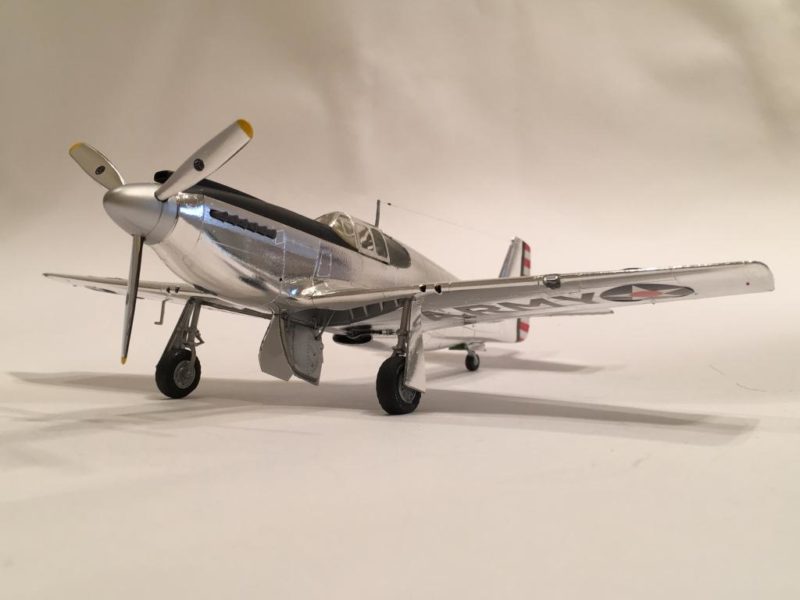
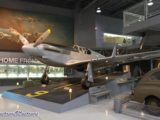

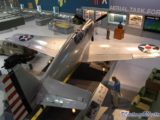
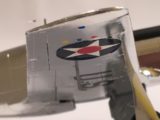
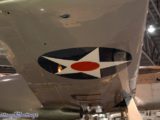
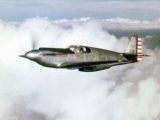

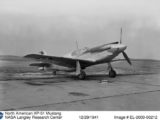
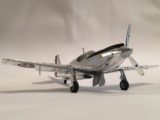
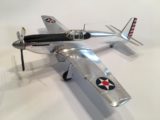
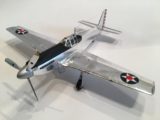
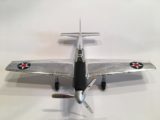
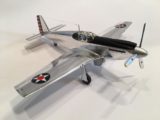
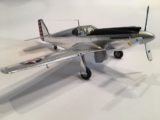
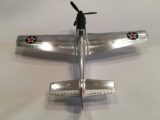
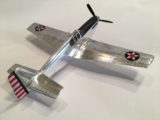
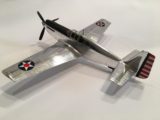
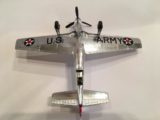
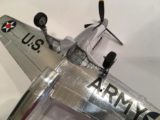
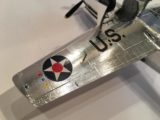
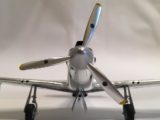
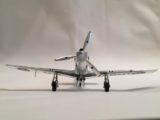
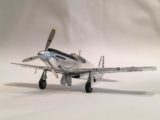
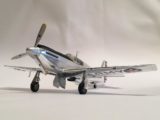
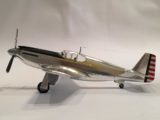
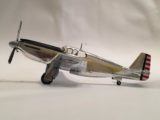
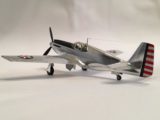
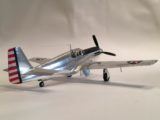
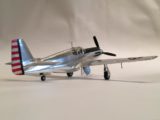
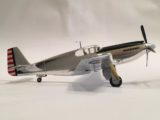
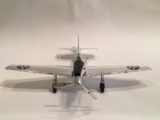
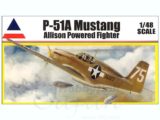

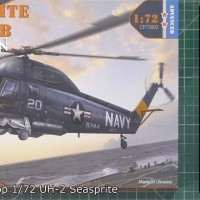
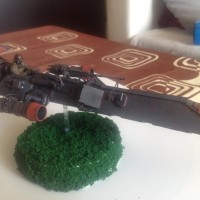
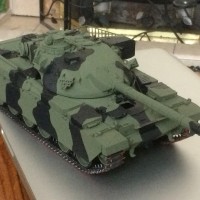
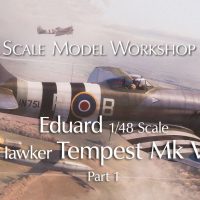
Great work!
Thanks Ken. I'm glad you liked it.
Beautiful rendering of that excellent kit, Louis...nice photography, too. I have that kit somewhere, but after seeing yours, I don't think I'll look for it anytime soon...(sigh). That turned out spectacularly, my friend. Wow!
Thanks Craig for the compliments.
I tried something new when taking the photos in another location of our house. I followed the advice of several of our Imodeler friends by using more light for the pictures.
Go ahead buddy and find your kit. Build it ! You will be glad you did.
Thanks again my friend...
Craig, have you ever seen the one the AAF painted in a black and white dazzle with OD uppers? Real eye grabber.
Absolutely beautiful ! And thanks for the info on the inner landing gear doors.
Thanks Bob. I try to include a little bit of information about the plane or the pilot in my articles. I hope it makes the article a little bit more interesting.
Great job Louis
Thanks for the compliments buddy.
BRAVO!
great work i LIKE!
P.k
Thanks PK.
Louis
Louis, I really like your prewar US aircraft theme! This one in particular, the natural metal shows off the lines beautifully. Great work with the foil, Gives me the twitch just thinking about the application.
Actually the application of the Bare Metal Foil isn't too hard. The hardest places are compound curves, but with a little practice even some of these areas can be done. I use a Q-tip and my fingers to smooth the foil down. It is time consuming though...
Thanks for the compliments my friend.
Louis, this is beautiful. This is one those schemes I can't believe is not done more often.
I do try to avoid controversies when commenting on models, however in this case I'm going to go out on a limb a little. I'm pretty sure you are all right with not filling in the rivets on this early version. I've seen plenty of photographic evidence showing early versions not having this done. I'm also just as certain someone will prove me wrong. The evidence is out there to go both ways.
As for your work here. I really like it. This is a beautiful, classic. One of my favorite models I've seen on this site. Thanks for sharing !
Thanks Terry.
The main reason I didn't bother with the wing rivets is because the restored plane at the EAA museum has the rivets showing.
You're quite possibly correct about the early Mustangs and filling in the wing. I knew about the ailerons and flaps not being treated this way.
I was able to take some nice photos of the A-36 that is owned and operated by the Collings Foundation during it's restoration. I can go back and try to find some of those pictures to see how the wing was done. Now you have me thinking...
I really appreciate the kind words about my plane.
Thanks again buddy !
Louis
Just wonderful!
Thanks Rob. I thank you Sir !
🙂 ... Greetings ... 🙂 :
Great work Louis, very nice work on the foil. It is always nice to see a prewar plane.
Thanks DE. The prewar planes are among my favorites too. 🙂
Wow, you used foil, I thought it was some sort chrome plated limited edition kit at first. It looks wonderful, whether or not it should have rivets doesn't matter.
The Bare Metal Foil isn't too hard to work with once you get the hang of it. It does look like real metal once applied. This one kind of reminds me of the old chrome plated "Hawk" kits that Testors released back in the late 1970's... except that it is way more accurate and a much better model than anything Hawk ever released. But then again this one probably has about 40 years of progress with model kit manufacturing behind it. Too bad that AM went out of business. Some of their kits are being re released by Italeri and Academy though.
Thanks again my friend.
I was going to mention the XP-51 in the EAA museum still has the guns in the nose, but it's the one in your photos so you already know that. Now that Paul's P-64 flew last year, I'm hoping this one gets the same treatment when the XP-82 is ready to fly! To see two North American prototypes in the air together! WOW! That would be fantastic! You are right about the wings. Most polished Mustangs have silver wings, but a lot of the time the ailerons and flaps are still left unpainted and polished. (Although EAA's XP-51 is painted entirely.) This turned out beautiful. I did notice your A-20 in the display case post a few weeks ago as it was teasing us. Can't wait to see that one as well. If there are any photos from the EAA museum you would like, let me know and I'll pop on over and shoot for you.
That would be an impressive sight to see, BOTH planes in the air at the same time ! You're very fortunate to have the museum so close at hand. One of these days after the weather gets better, I may ask you for a few photos. I really appreciate the offer. I'll send you a PM sometime later today. Thanks again my friend.
Thats a real piece of art, Louis !
Lovely build and again a well written article.
Thanks Bernd. I'm glad that you enjoyed the article and the photos of my early Mustang.
I appreciate the compliments friend.
Impressive job, Louis. And explanations, build story are much interesting to me. Congratulations.
Thank you Christian. I try to make the articles interesting to read. I'm glad to hear that you enjoyed them.
Louis
Always good to see an Allison engined P-51! Love the metal finish - well done Louis
Thanks David. I appreciate the compliments. The early Mustangs are very graceful. Just something about them...
Late 2 the party again, but I love it. Yes the US prototypes were beautiful sculptures. The '38, '39' and '40 were gaw-juss too. Great model and foil job.
Thanks Bill. I appreciate the compliments Sir ! I agree with you. It was a great time for brilliant planes indeed.
Wow, beautiful job. Tempted to do mne the same.
Thanks Paul. Go for it. You will like the end results. You normally don't see too many early Mustangs in this type of markings.
Nice! I've never used the foil, but you seem to have a steady hand at it! It is an eye-catching scheme.
The foil is really not that hard to use. It takes a little practice but once you get the hang of it, the rest is pretty easy. I really like to use this material for natural metal finishing since it really is a metal. One trick I sometimes use is I take very fine steel wool and lightly brush the foil in one direction while it is still adhered to the backing. Then when you peel it off and install it on your model it gives your plane a little more different shade of metal. The foil also has a natural grain to it and if you rotate the orientation of the grain it alters the appearance too. These things along with using different shades helps to bring the finish to life.
I'm glad you enjoyed the article and thanks again Greg.